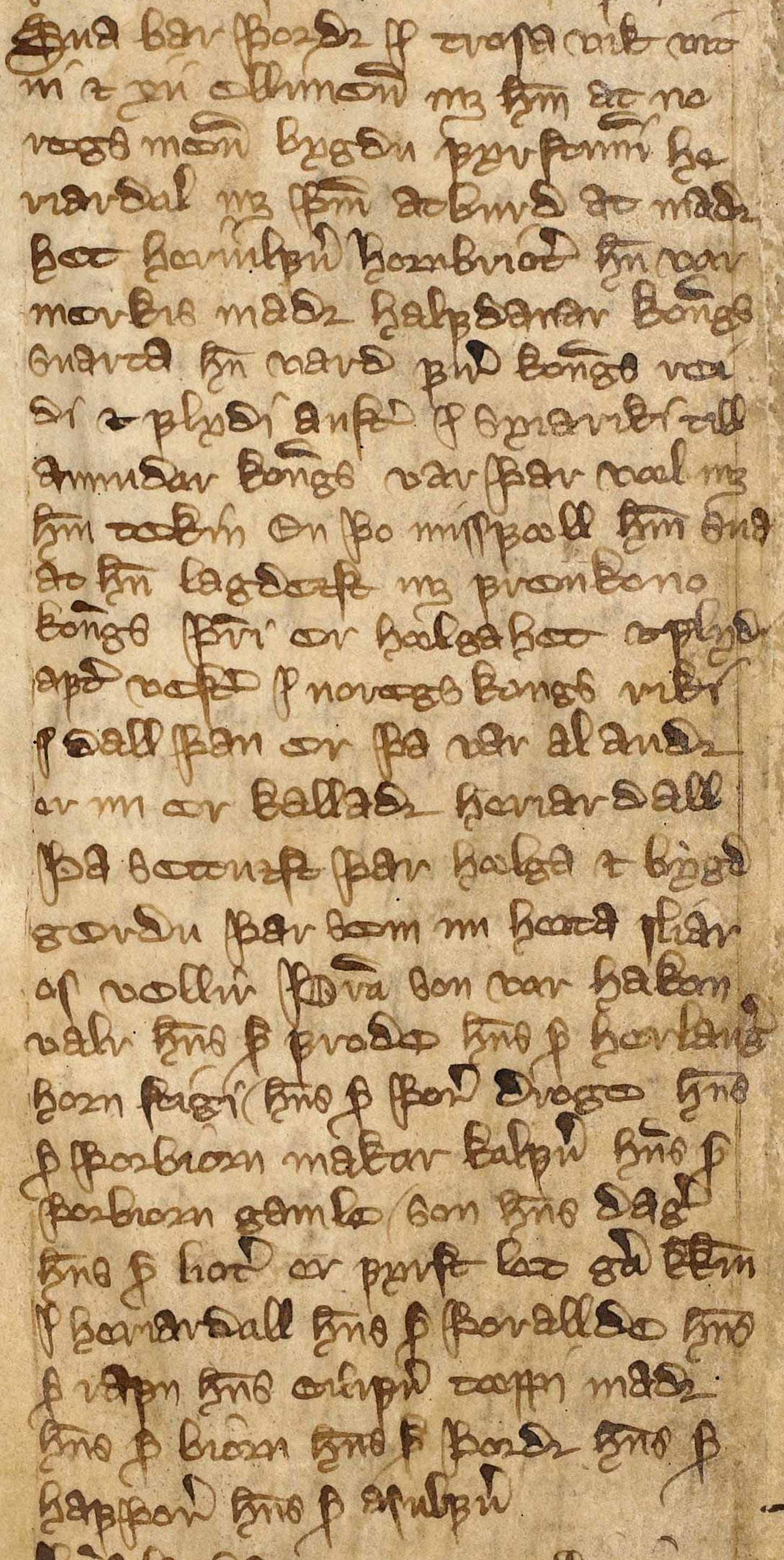This interesting short tale is found in a legal document (2v of AM 114 a 4to1) describing the border between Sweden and Norway, written in 1268 or 1273. It is included as proof that the land Harrierdale (Swedish Härjedal, ON Herjáardal) was settled by Norwegians and should therefore belong to Norway, as it did at the time. The land was later transferred to Sweden at the treaty of Brömsebro in 1645, and remains a Swedish province today.
The following text has been normalized by adding punctuation and acutes for long vowels, distinguishing between u - v and i - j, and replacing æ with ę. I have not edited out any possible dialectal traits, although there are hardly any to begin with (one notes dall for dalr, son for sonr, -fver for -fr and Rafn for Hrafn). Indeed the expression itself is highly classical, and the language of the retelling, including the beginning with maðr hét ‘a man was called’, reminds strongly of the Icelandic saws.
The story can be dated by the kings mentioned to the 9th century. The paternal lineage (consisting of 15 listed generations) listed at the end is in order to lend legitimacy to the oath, and we may thus assume that Þórðr was the son of Ásulfr, in which case he would have inherited his great grandfather’s name, something not unusual. As far as the names are concerned, they are still thoroughly Norse-Germanic; there are no Latinate names. Since they are almost all in the nominative form in the original, I have not included the nominative forms in parenthesis after my English forms. Several of the men named so have nicknames; several of these are harder to translate, some even impossible. They refer to events in their lives which are now lost and forgotten.
As for the authenticity of this account, it is impossible to say, but Thurfrith and twelve eldermen were willing to swear oaths on its being true. Taking an average generation length of 30 years, we end up with 450 years between Thurfrith and Harwolf and Holy. Since the witness was given around 1270, this would date the settlement to around 820, something that agrees with the reign of Halfdan the Black. An obvious historical anachronism is seen in Halfdan being called the king of Norway, since he in reality only controlled a small part of the country. This hardly falsifies the account; Halfdan was the father of Harald Fairhair, who did unite Norway, and anyway, such historical nuance should not be expected in an cursory document written around four yearhundreds after the unification.
Original: Svá bar Þórðr í Trosavík vitni ok tolf ellimenn með honum at Noregs menn bygðu fyrstunni Herjárdal með þeim atburð at maðr hét Herjulfver hornbrjótr; hann var merkismaðr Halfdanar konongs svarta. Hann varð firir konongs reiði, ok flýði austr í Svíaríki till Anundar konongs. Var þar vęl með honum tekin, en þó missfęll honum svá, at hann lagðizt með frenkono konongs, þeirri er Hęlga hét, ok flýði aftr vestr í Noregs konongs ríki, í dall þan, er þá var alauðr, en nú er kallaðr Herjárdall. Þá settuzt þau Hęlga, ok bygð gerðu þar, sem nú heita Slíarósvellir. Þeirra son var Hákon valr; hans son Fróðe; hans son Herlaugr hornstigi; hans son Þórer dróge; hans son Þórbjorn makarkalfver; hans son Þórbjorn gamle; son hans Dagr; hans son Ljótr, er fyrst lét gera kirkju í Herjárdall; hans son Þóralde; hans son Rafn; hans Eilífver tęppimaðr; hans son Bjorn; hans son Þórðr; hans son Hafþórer; hans son Ásulfver.
English: Thus Thurfrith in Trosewic bore witness, and twelve eldermen with him, that men of Norway first inhabited Harrierdale, under the circumstance that a man was called Harwolf horn-breaker. He was the standard-bearer of king Halfdan the black. He became subject to the king’s wrath and fled east into Sweden, to king Anund. There he was well received, but he made the mistake of sleeping with the king’s kinswoman, who was named Holy, and fled back west into the realm of the king of Norway, into that valley which then was all empty, but is now called Harrierdale. Then he and Holy settled down and made a settlement at the place which is now called Slighorwald. There son was Hathkin wale; his son Frood; his son Harley horn-stier; his son Thurer drog; his son Thurbern makecalf; his son Thurbern the old; his son Day; his son Leat, who had the first church made in Harrierdale; his son Thurold; his son Raven; his [son] Anliv tepman; his son Bern; his son Thurfrith; his son Hafthurer; his son Oswolf.
Rikssvenska: Så bar Tord i Trosavik vittne—och tolv åldermän med honom—att Norges män först bebyggde Härjedal, med händelsen att en man hette Härjulv hornbryt. Han var konung Halvdan svartes märkesman, men föll i kungens onåd, och flydde österut i Sveariket, till konung Anund. Där blev han väl emottagen, men begick misstaget att han lades med konungens fränka, hon som hette Helga, och flydde åter västerut i Norges konungs rik i den dal, som då var allöde, men nu är kallad Härjedal. Då bosatte sig han och Helga, och gjorde en bygd på den plats som nu heter Slyrosvallarna. Deras son var Håkon val; hans son Frode; hans son Härlög hornstige; hans son Tore droge; hans son Torbjörn makakalver; hans son Torbjörn gamle; son hans Dag; hans son Ljut, som först lät göra kyrka i Härjedal; hans son Torålde; hans son Ramn; hans [son] Eliv täppeman; hans son Björn; hans son Havtore; hans son Åsulv.
Readable online at handrit.is: https://handrit.is/manuscript/view/en/AM04-0114-a/7




